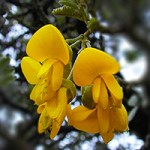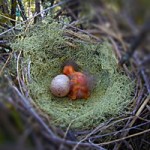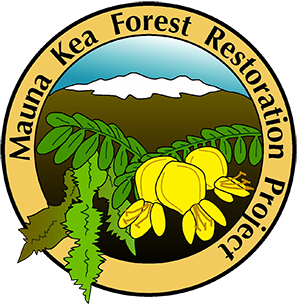

Their only home
Take a journey through Mauna Kea’s high-elevation dry forest. High above tropical rain clouds, this forest has adapted to an extremely dry and cold climate normally found on continents. You will see plants and animals found nowhere else in the world as you explore this special place.
This forest is one of the last large tracts of dry forest left in Hawai‘i. While there are serious threats to this forest, restoration efforts are helping to protect this special home of a critically endangered bird, the palila.
Learn more... |
Welcome |
A Threatened Home |
A Living Legacy |
The one and only Māmane
Māmane (Sophora chrysophylla) is only found in Hawai‘i and is the dominant tree of the high-elevation dry forest of Mauna Kea.
It can grow from a large shrub to a tree, with some reaching over 40 feet in height. The māmane’s bright yellow flowers eventually turn into seed pods. Palila depend on these nutritious seeds for food, and are immune to the toxic alkaloids within all the seeds.
Though once common in Hawai‘i’s dry areas, māmane now grow primarily in the high-elevation forest between 5,800 to 10,000 feet.
Immature, green māmane seeds make up most of the palila’s diet, although they also eat flowers and leaf buds. Native Cydia caterpillars found in the seed pods are protein-rich and an important food for growing chicks.




A special bird worth protecting
 Found only on the upper slopes of Mauna Kea, the critically endangered palila has a vibrant yellow head, a strong bill, and a delightful call. This spectacular bird is an important part of our Hawaiian heritage worth protecting.
Found only on the upper slopes of Mauna Kea, the critically endangered palila has a vibrant yellow head, a strong bill, and a delightful call. This spectacular bird is an important part of our Hawaiian heritage worth protecting.
 The last of the finch-billed Hawaiian honeycreepers in the main Hawaiian Islands, palila depend on the māmame of this forest for their main food source. Palila now live in less than 5% of their former range and are considered critically endangered. The palila’s population declined rapidly after 2003, as prolonged and severe drought and browsing damage reduced the health of the māmane forest.
The last of the finch-billed Hawaiian honeycreepers in the main Hawaiian Islands, palila depend on the māmame of this forest for their main food source. Palila now live in less than 5% of their former range and are considered critically endangered. The palila’s population declined rapidly after 2003, as prolonged and severe drought and browsing damage reduced the health of the māmane forest.
“Numerous in its special haunts, tame, and in foggy weather, constantly uttering its callnote, the palila of the more local birds is one of the easiest to observe....”
—R.C.L. Perkins, ca.1892
PALILA (Loxioides bailleui)
CRITICALLY ENDANGERED
Plumage
- Yellow head. Males have yellow feathers that extend down the back of the head to the shoulders. On females, this area usually has more gray feathers.
- Gray back and whitish belly.
- Black bill on adults; yellowish-orange bill on fledglings.
Size
- Length: 7.5 inches
- Weight: 1.3 ounces
Food
- Māmane provides over 90% of the palila’s diet. Palila eat the immature seeds, flower parts and nectar, young leaves and buds, and caterpillars in the seeds.
- Fruit from naio trees are the second most common food eaten by palila. It accounts for less than 10% of their diet.
Reproduction
 Low reproductive rates.
Low reproductive rates.- The females select new nest sites each year and the males help them build them.
- Average number of eggs laid per nest is 2.
- One egg laid per day.
- Incubation lasts 17 days and female does all of the incubation.
- Nestlings typically start fledging at 25 days old. Parents continue to feed fledglings for up to four months.
Movement Patterns
- Typically spend their entire life within 3 miles of their nest tree.
- Need to move between higher and lower elevation sites of māmane forest to follow the availability of the pods.
Survival and Age
- 1st year of life: 36% survival; 2 years and older: 64% survival.
- Oldest known palila in the wild: at least 17 years.[/box]


